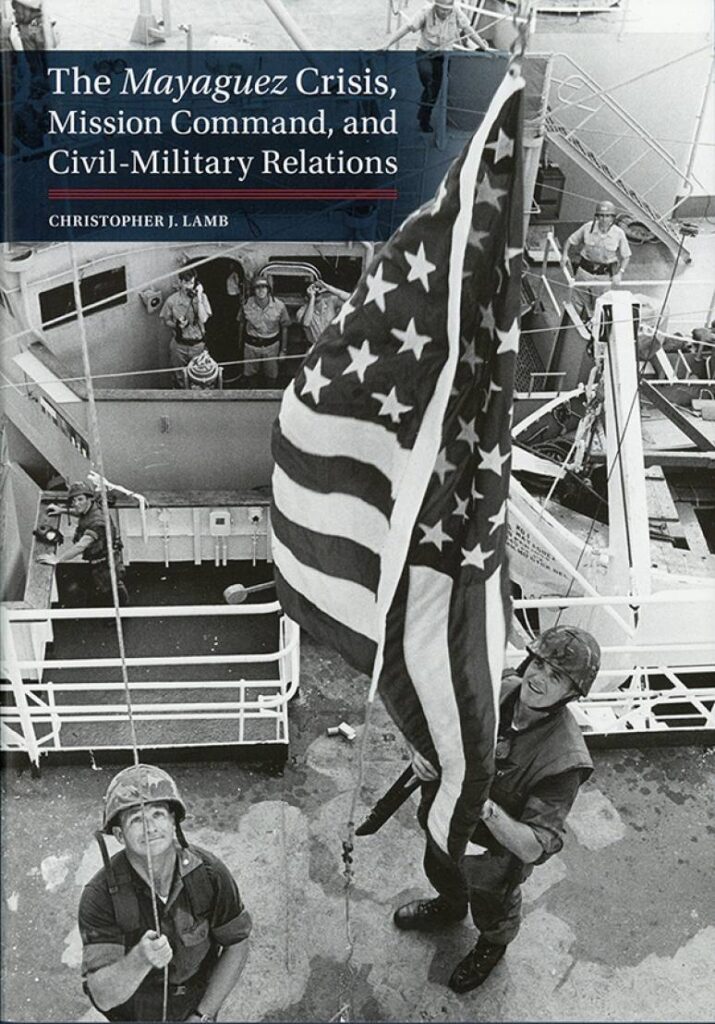Reviewed by LCDR Joseph L. Ilk, SC, USNR (Ret.)
“On May 12, 1975 – only two weeks after the fall of Saigon and the collapse of South Vietnam – Cambodian Khmer Rouge forces boarded and seized the U.S. merchant vessel SS Mayaguez in international waters and took its crew hostage.” Thus begins Dr. Christopher J. Lamb’s analysis of the Mayaguez crisis.
Lamb devoted five years of his life to understanding the Mayaguez crisis while earning his master’s and doctorate in the 1980’s. However, in the past few years new sources of information have become available, including interviews with primary participants as well as previously classified material. These enabled Lamb to re-examine his findings and clarify what occurred between May 12 and May 15th, 1975, in a new book – The Mayaguez Crisis, Mission Command and Civil Military Relations (Joint History Office, Office of the Chairman of Joint Chiefs of Staff, 2018).
This book is divided into two parts. The first details the events of the four-day crisis, while the second provides explanations for American actions during the crisis among other findings and prescriptions. Lamb provides a narrative of each day’s events as well as a timeline of key events and decisions in Washington, DC and Cambodia’s respective time zones. He also provides a chart reflecting the military chain of command, and maps illustrating the capture of the Mayaguez, the Marine Corps intervention on Koh Tang Island, carrier air strikes, and command and control communications, in addition to the location of various islands in the area and air bases in Thailand.
Because the seizure of the Mayaguez occurred two weeks after the fall of Saigon, a large number of American military assets had already left the area. President Ford stated that he would personally manage the crisis and he did so with the National Security Council (NSC). This is the only occasion in which a President managed a crisis through the NSC vice a smaller group of personal advisors. In managing the crisis, President Ford and Secretary of State Kissinger wanted to demonstrate that the United States was still a decisive force in Southeast Asia so as to reassure allies and deter North Korean aggression. President Ford and Secretary Kissinger were particularly motivated by the memory of North Korean forces capturing USS Pueblo in 1968 and shooting down a Lockheed EC-121 Warning Star in 1969. The primary objective for both men was preserving the credibility of American deterrence.
President Ford ordered that all Cambodian ships leaving Koh Tang Island be destroyed but Secretary of Defense Schlesinger, in consultation with senior military advisors, decided not to sink Cambodian naval vessels that were reported to be carrying “Caucasians” during the movement of the Mayaguez crew. Once the Mayaguez crew was safe, they stopped sinking Cambodian vessels entirely. Schlesinger was dismissed by Ford in November 1975, and there has been much subsequent debate regarding whether the Secretary was insubordinate in failing to comply with the President’s order.
The attempt to rescue the Mayaguez crew from Koh Tang Island was founded on bad intelligence, as the crew had been released before the operation began. Moreover, this futile effort was further complicated by conflicting intelligence assessments. The Marines charged with the extraction operation were not informed of the DIA estimates suggesting there were more substantial Cambodian forces and artillery on Koh Tang than CINCPAC intelligence intimated. Ultimately, 41 servicemen lost their lives during the extraction operation, including three Marines left behind on Koh Tang. The names of those lost in this last battle of the Vietnam War are listed on the Vietnam Veterans memorial wall.
The Mayaguez crisis revealed a lack of trust between the President’s advisors as they struggled to acquire adequate intelligence and come to a consensus as to its veracity. Moreover, as Lamb notes, Ford relied heavily on Kissinger for advice and Kissinger did not want a diplomatic resolution, fearing that this would make the U.S. look weak. Though it was not known why the Mayaguez was seized in 1975, Lamb argues it was entirely plausible that a local Cambodian commander seized the ship without authorization from the Cambodian government in an attempt to defend precious oil deposits. At the time of the crisis there was an ongoing dispute between Cambodia and Vietnam over the resource wealth in the waters where the Mayaguez was seized.
The Mayaguez Crisis, Mission Command, and Civil-Military Relations presents an excellent analysis of what transpired during the Mayaguez crisis, significantly updating Lamb’s prior research by addressing in greater detail such critical factors as Secretary Kissinger’s influence on President Ford and Secretary Schlesinger’s role in the saving the Mayaguez crew members from U.S. airstrikes. He also reflects on how the crisis contributed to the defense reforms of the 1980’s. This book is an excellent addition to any library on managing crisis.
The Mayaguez Crisis, Mission Command, and Civil-Military Relations (Christopher J. Lamb, Office of the Chairman of the Joint Chiefs of Staff, Washington, D.C., 2021).


